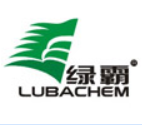Paraquat
Chemical name:1' 1-dimethyl -4'4-bipyridinium dichloride
Common name:Paraquat Dichloride
Molecular formula:C12H14N2Cl2
Structural formula:
 CAS No.:1910-42-5 ( Paraquat dichloride ); 4685-14 -7 ( Paraquat ion )
CAS No.:1910-42-5 ( Paraquat dichloride ); 4685-14 -7 ( Paraquat ion )
Technical:
Appearance: Blue-green homogeneous liquid
Specification: Paraquat 45% W/W TC (dichloride content)
Paraquat 42% W/W TC (dichloride content)
Paraquat 50% W/V TC (dichloride content)
Packing: Plastic drum, 220kg net each.
Capacity: 30000 MT (42% W/W TC) p.a.
Formulation:
Appearance: Blue-green homogeneous liquid
Specification: Paraquat 200 G/L SL (ion content)
Paraquat 250 G/L SL (ion content)
Paraquat 240 G/L SL (dichloride content)
Appearance: Gray granule
Specification: Paraquat 50% W/W SG(Paraquat ion content)
Packing: Plastic drum, 200L, 20L, 5L, 1L each. Other suitable packing can be adopted according to the requirements of customers.
Uses:
A broad-spectrum, quick-acting, non-selective contact herbicide, widely used to control weeds in cultivated and non-cultivated land. It is used pre-plant or pre-emergence on vegetables, grains, cotton, grasses, sugar cane, peanuts, potatoes, and tree plantation areas; post-emergence around fruit crops, vegetables, trees, vines, grains, soybeans, and sugar cane; Also used for control of aquatic weeds, and as a defoliant for cotton and sunflower.
Paraquat is also called Ticao Kuai, Gramoxone, and Paraquat. It is a herbicide. The chemical name is "1,1'-dimethyl-4,4'-bipyridine chloride". It is formed by the reaction of pyridine, sodium metal and dimethyl sulfate. soluble in water. It has contact and conductivity effects, and it loses efficacy quickly after contact with the soil, so it is a herbicide that does not harm the soil.
IUPAC
1-methyl-4-(1-methylpyridin-1-ium-4-yl)pyridin-1-ium;dichloride
SMILES
C[N+]1=CC=C(C=C1)C2=CC=[N+](C=C2)C.[Cl-].[Cl-]







